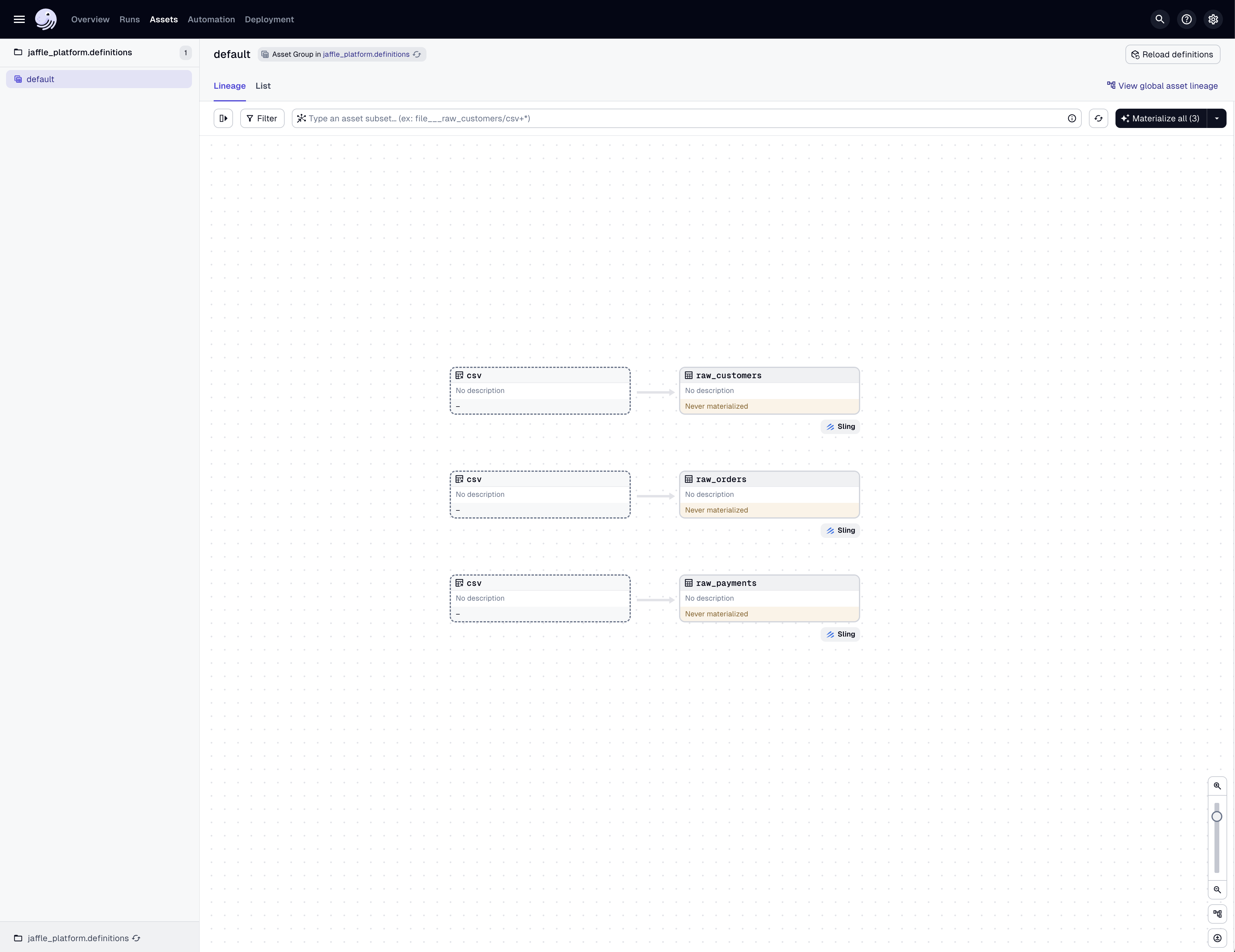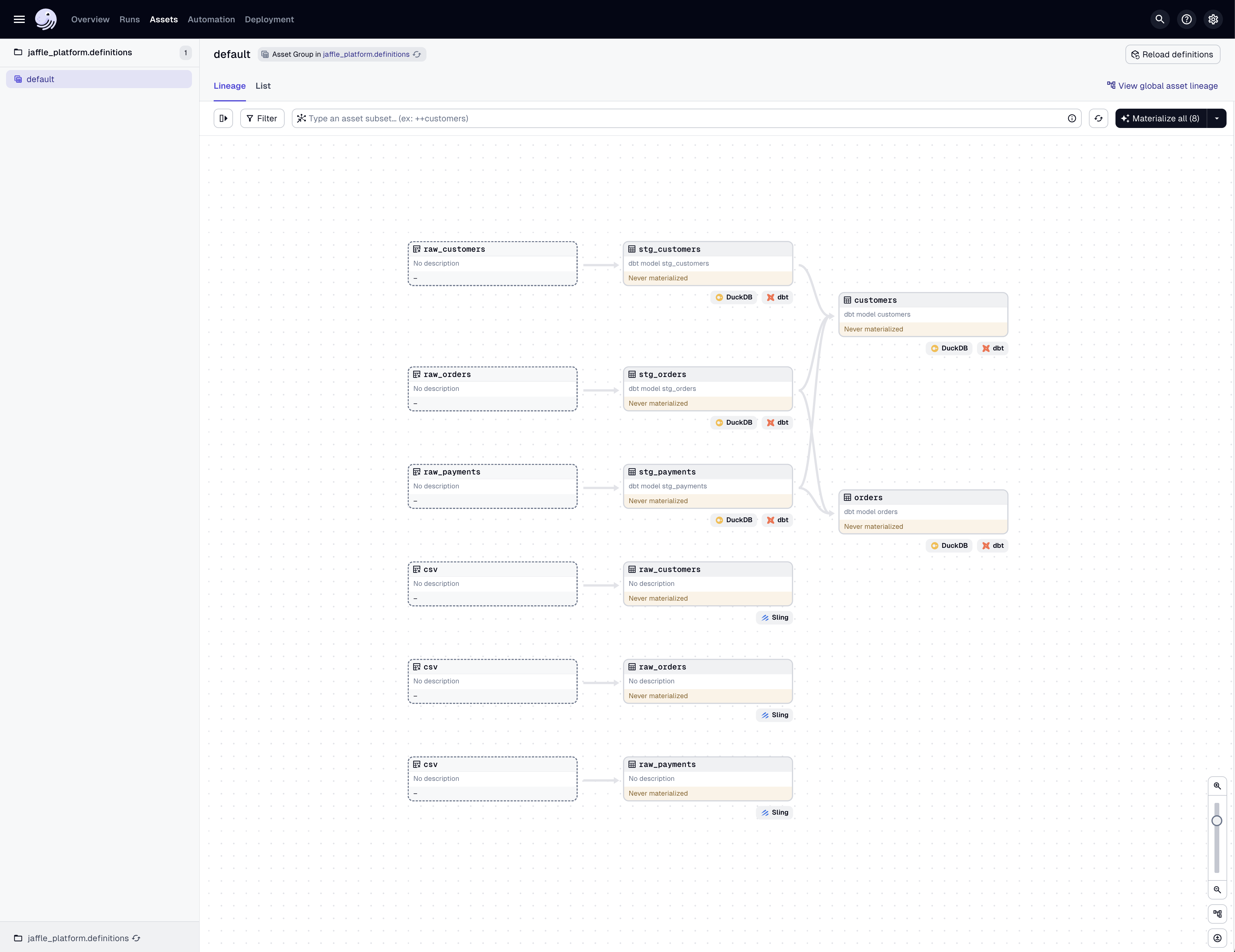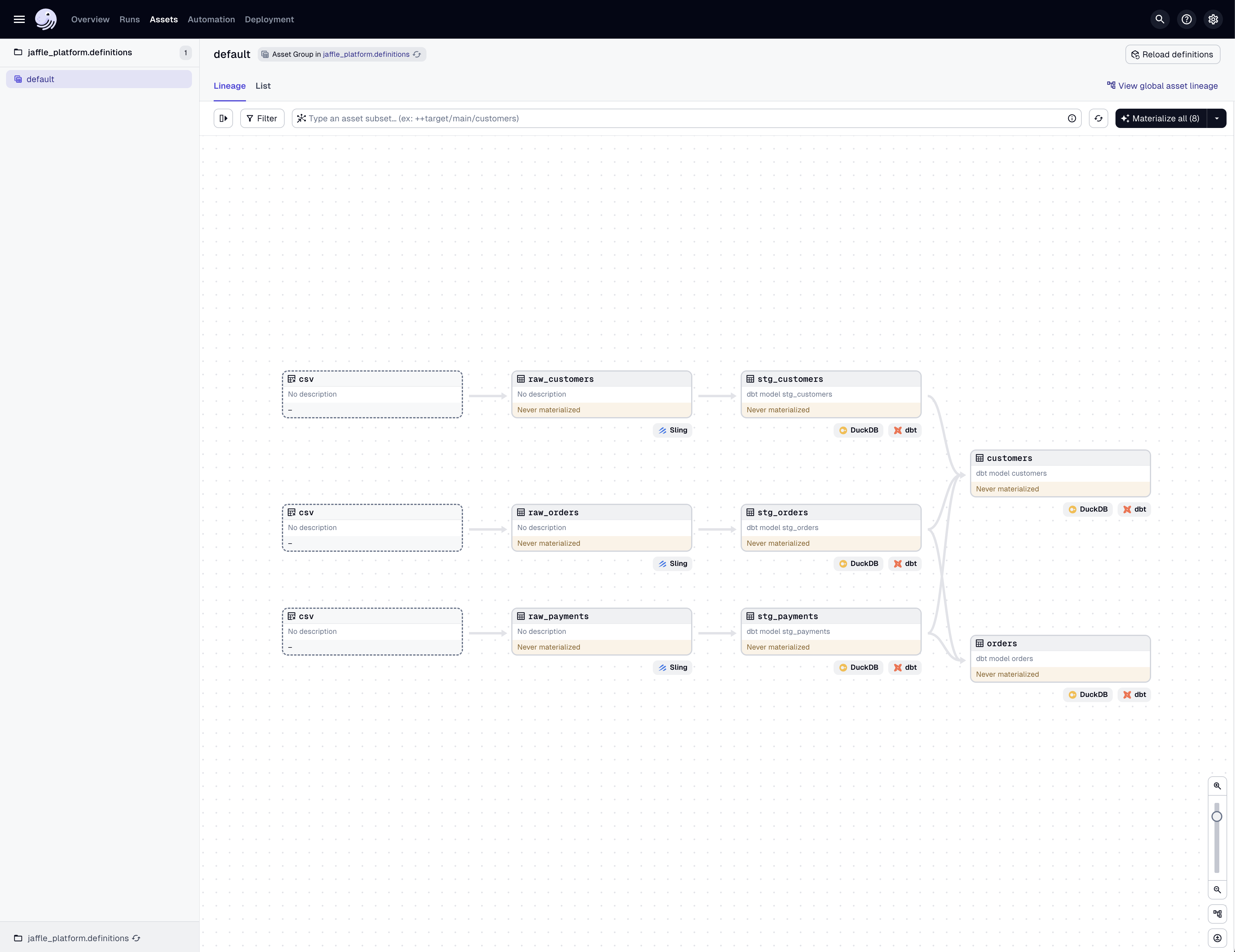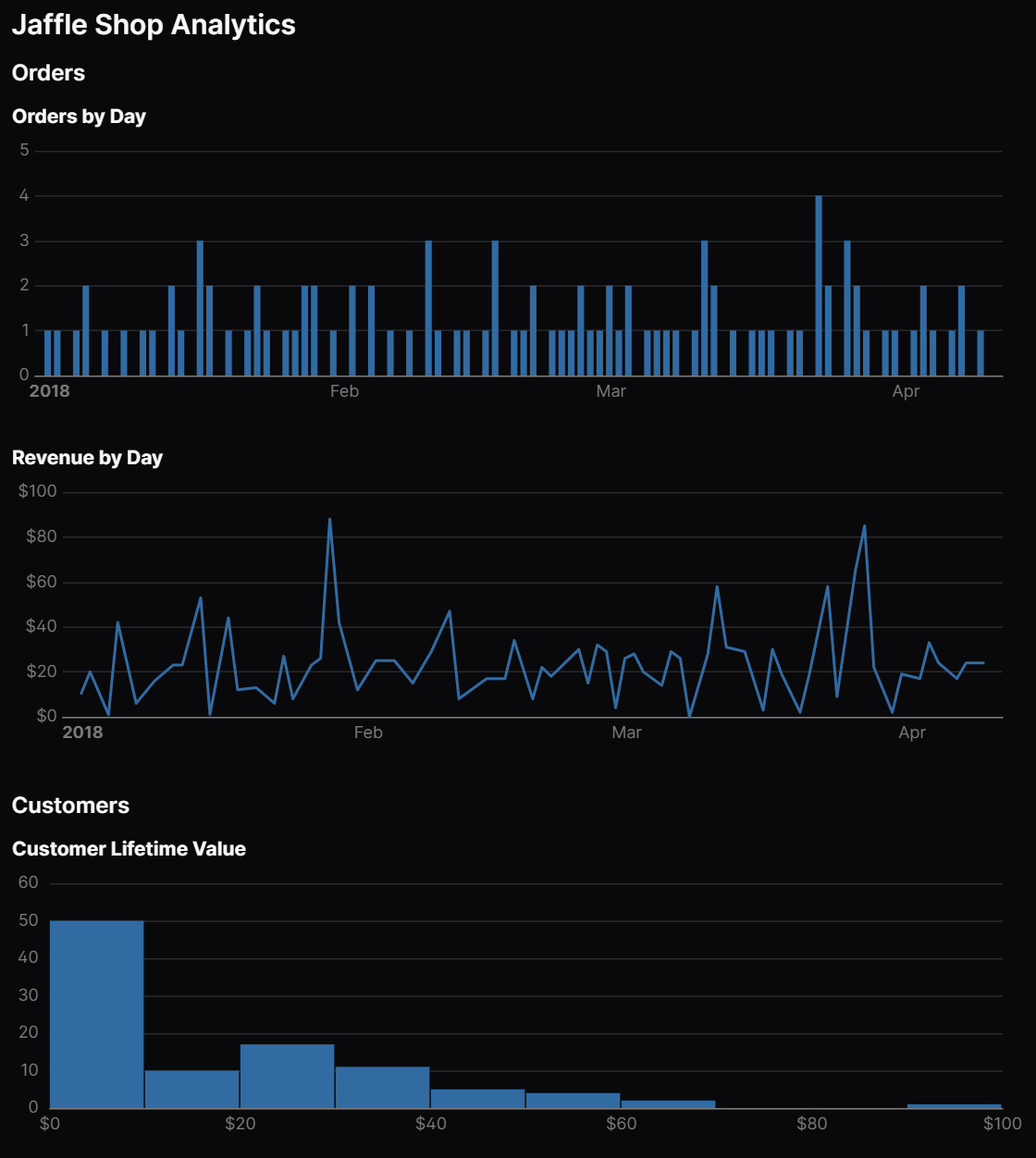Components ETL pipeline tutorial
This feature is considered in a preview stage and is under active development. It can change significantly, or be removed completely. It is not considered ready for production use.
Setup
1. Install project dependencies
To complete this tutorial, you must install uv and dg.
First, install duckdb for a local database and tree to visualize project structure:
- Mac
- Windows
- Linux
tree is optional and is only used to produce a nicely formatted representation of the project structure on the comand line. You can also use find, ls, dir, or any other directory listing command.
2. Scaffold a new project
After installing dependencies, scaffold a components-ready project:
dg scaffold project jaffle-platform
Creating a Dagster project at /.../jaffle-platform.
Scaffolded files for Dagster project at /.../jaffle-platform.
...
The dg scaffold project command builds a project at jaffle-platform and initializes a new Python
virtual environment inside it. When you use dg's default environment management behavior, you won't need to worry about activating this virtual environment yourself.
To learn more about the files, directories, and default settings in a project scaffolded with dg scaffold project, see "Creating a project with components".
Ingest data
1. Add the Sling component type to your environment
To ingest data, you must set up Sling. We can list the component types available to our project with dg list plugins. If we run this now, the Sling component won't appear, since the dagster package doesn't contain components for specific integrations (like Sling):
dg list plugins
┏━━━━━━━━━┳━━━━━━━━━━━━━━━━━━━━━━━━━━━━━━━━━━━━━━━━━━━━━━━━━━━━━━━━━━━━━━━━━━━━━━━━━━━━━━━━━━━━━━━━━━━━━━━━━━━━━━━━━━━━┓
┃ Plugin ┃ Objects ┃
┡━━━━━━━━━╇━━━━━━━━━━━━━━━━━━━━━━━━━━━━━━━━━━━━━━━━━━━━━━━━━━━━━━�━━━━━━━━━━━━━━━━━━━━━━━━━━━━━━━━━━━━━━━━━━━━━━━━━━━━━━┩
│ dagster │ ┏━━━━━━━━━━━━━━━━━━━━━━━━━━━━━━━━━━━━━━━━━━━━━━━━━━━━━━━━━━━━━┳━━━━━━━━━━━━━━━━━━━━┳━━━━━━━━━━━━━━━━━━━━━┓ │
│ │ ┃ Symbol ┃ Summary ┃ Features ┃ │
│ │ ┡━━━━━━━━━━━━━━━━━━━━━━━━━━━━━━━━━━━━━━━━━━━━━━━━━━━━━━━━━━━━━╇━━━━━━━━━━━━━━━━━━━━╇━━━━━━━━━━━━━━━━━━━━━┩ │
│ │ │ dagster.asset │ Create a │ [scaffold-target] │ │
│ │ │ │ definition for how │ │ │
│ │ │ │ to compute an │ │ │
│ │ │ │ asset. │ │ │
│ │ ├─────────────────────────────────────────────────────────────┼────────────────────┼─────────────────────┤ │
│ │ │ dagster.components.DefinitionsComponent │ An arbitrary set │ [component, │ │
│ │ │ │ of dagster │ scaffold-target] │ │
│ │ │ │ definitions. │ │ │
│ │ ├─────────────────────────────────────────────────────────────┼────────────────────┼─────────────────────┤ │
│ │ │ dagster.components.DefsFolderComponent │ A folder which may │ [component, │ │
│ │ │ │ contain multiple │ scaffold-target] │ │
│ │ │ │ submodules, each │ │ │
│ │ │ │ which define │ │ │
│ │ │ │ components. │ │ │
│ │ ├─────────────────────────────────────────────────────────────┼────────────────────┼───────────────�──────┤ │
│ │ │ dagster.components.PipesSubprocessScriptCollectionComponent │ Assets that wrap │ [component, │ │
│ │ │ │ Python scripts │ scaffold-target] │ │
│ │ │ │ executed with │ │ │
│ │ │ │ Dagster's │ │ │
│ │ │ │ PipesSubprocessCl… │ │ │
│ │ ├─────────────────────────────────────────────────────────────┼────────────────────┼─────────────────────┤ │
│ │ │ dagster.schedule │ Creates a schedule │ [scaffold-target] │ │
│ │ │ │ following the │ │ │
│ │ │ │ provided cron │ │ │
│ │ │ │ schedule and │ │ │
│ │ │ │ requests runs for │ │ │
│ │ │ │ the provided job. │ │ │
│ │ ├─────────────────────────────────────────────────────────────┼────────────────────┼─────────────────────┤ │
│ │ │ dagster.sensor │ Creates a sensor │ [scaffold-target] │ │
│ │ │ │ where the │ │ │
│ │ │ │ decorated function │ │ │
│ │ │ │ is used as the │ │ │
│ │ │ │ sensor's │ │ │
│ │ │ │ evaluation │ │ │
│ │ │ │ function. │ │ │
│ │ └─────────────────────────────────────────────────────────────┴────────────────────┴─────────────────────┘ │
└─────────┴────────�────────────────────────────────────────────────────────────────────────────────────────────────────┘
To make the Sling component available in your environment, install the dagster-sling package:
uv add dagster-sling
When you run commands like dg list plugins, dg obtains the results by resolving a project environment and querying it. In this case, the project environment was set up as part of the dg scaffold project command. The pyproject.toml in newly scaffolded projects contains a setting tool.dg.project.python_environment = "persistent_uv". This tells dg to expect a uv-managed virtual environment to be present in the project root directory. (This can be confirmed by the presence of a uv.lock file.)
2. Confirm availability of the Sling component type
To confirm that the dagster_sling.SlingReplicationCollectionComponent component type is now available, run the dg list plugins command again:
dg list plugins
Using /.../jaffle-platform/.venv/bin/dagster-components
┏━━━━━━━━━━━━━━━┳━━━━━��━━━━━━━━━━━━━━━━━━━━━━━━━━━━━━━━━━━━━━━━━━━━━━━━━━━━━━━━━━━━━━━━━━━━━━━━━━━━━━━━━━━━━━━━━━━━━━━━━┓
┃ Plugin ┃ Objects ┃
┡━━━━━━━━━━━━━━━╇━━━━━━━━━━━━━━━━━━━━━━━━━━━━━━━━━━━━━━━━━━━━━━━━━━━━━━━━━━━━━━━━━━━━━━━━━━━━━━━━━━━━━━━━━━━━━━━━━━━━━━┩
│ dagster │ ┏━━━━━━━━━━━━━━━━━━━━━━━━━━━━━━━━━━━━━━━━━━━━━━━━━━━━━━━━━━━━━┳━━━━━━━━━━━━━━━━━━┳━━━━━━━━━━━━━━━━━┓ │
│ │ ┃ Symbol ┃ Summary ┃ Features ┃ │
│ │ ┡━━━━━━━━━━━━━━━━━━━━━━━━━━━━━━━━━━━━━━━━━━━━━━━━━━━━━━━━━━━━━╇━━━━━━━━━━━━━━━━━━╇━━━━━━━━━━━━━━━━━┩ │
│ │ │ dagster.asset │ Create a │ [scaffold-targ… │ │
│ │ │ │ definition for │ │ │
│ │ │ │ how to compute │ │ │
│ │ │ │ an asset. │ │ │
│ │ ├─────────────────────────────────────────────────────────────┼──────────────────┼─────────────────┤ │
│ │ │ dagster.components.DefinitionsComponent │ An arbitrary set │ [component, │ │
│ │ │ │ of dagster │ scaffold-targe… │ │
│ │ │ │ definitions. │ │ │
│ │ ├─────────────────────────────────────────────────────────────┼──────────────────┼─────────────────┤ │
│ │ │ dagster.components.DefsFolderComponent │ A folder which │ [component, │ │
│ │ │ │ may contain │ scaffold-targe… │ │
│ │ │ │ multiple │ │ │
│ │ │ │ submodules, each │ │ │
│ │ │ │ which define │ │ │
│ │ │ │ components. │ │ │
│ │ ├─────────────────────────────────────────────────────────────┼──────────────────┼─────────────────┤ │
│ │ │ dagster.components.PipesSubprocessScriptCollectionComponent │ Assets that wrap │ [component, │ │
│ │ │ │ Python scripts │ scaffold-targe… │ │
│ │ │ │ executed with │ │ │
│ │ │ │ Dagster's │ │ │
│ │ │ │ PipesSubprocess… │ │ │
│ │ ├─────────────────────────────────────────────────────────────┼──────────────────┼─────────────────┤ │
│ │ │ dagster.schedule │ Creates a │ [scaffold-targ… │ │
│ │ │ │ schedule │ │ │
│ │ │ │ following the │ │ │
│ │ │ │ provided cron │ │ │
│ │ │ │ schedule and │ │ │
│ │ │ │ requests runs │ │ │
│ �│ │ │ for the provided │ │ │
│ │ │ │ job. │ │ │
│ │ ├─────────────────────────────────────────────────────────────┼──────────────────┼─────────────────┤ │
│ │ │ dagster.sensor │ Creates a sensor │ [scaffold-targ… │ │
│ │ │ │ where the │ │ │
│ │ │ │ decorated │ │ │
│ │ │ │ function is used │ │ │
│ │ │ │ as the sensor's │ │ │
│ │ │ │ evaluation │ │ │
│ │ │ │ function. │ │ │
│ │ └─────────────────────────────────────────────────────────────┴──────────────────┴─────────────────┘ │
│ dagster_sling │ ┏━━━━━━━━━━━━━━━━━━━━━━━━━━━━━━━━━━━━━━━━━━━━━━━━━━━┳━━━━━━━━━━━━━━━━━━━━━━┳━━━━━━━━━━━━━━━━━━━━━━━┓ │
│ │ ┃ Symbol ┃ Summary ┃ Features ┃ │
│ │ ┡━━━━━━━━━━━━━━━━━━━━━━━━━━━━━━━━━━━━━━━━━━━━━━━━━━━╇━━━━━━━━━━━━━━━━━━━━━━╇━━━━━━━━━━━━━━━━━━━━━━━┩ │
│ │ │ dagster_sling.SlingReplicationCollectionComponent │ Expose one or more │ [component, │ │
│ │ │ │ Sling replications │ scaffold-target] │ │
│ │ │ │ to Dagster as │ │ │
│ │ │ │ assets. │ │ │
│ │ └───────────────────────────────────────────────────┴──────────────────────┴───────────────────────┘ │
└───────────────┴──────────────────────────────────────────────────────────────────────────────────────────────────────┘
3. Create a new instance of the Sling component
Next, create a new instance of this component type:
dg scaffold 'dagster_sling.SlingReplicationCollectionComponent' ingest_files
Using /.../jaffle-platform/.venv/bin/dagster-components
This adds a component instance to the project at jaffle_platform/defs/ingest_files:
tree src/jaffle_platform
src/jaffle_platform
├── __init__.py
├── definitions.py
├── defs
│ ├── __init__.py
│ └── ingest_files
│ ├── component.yaml
│ └── replication.yaml
└── lib
└── __init__.py
4 directories, 6 files
A single file, component.yaml, was created in the component folder. The component.yaml file is common to all Dagster components, and specifies the component type and any parameters used to scaffold definitions from the component at runtime.
type: dagster_sling.SlingReplicationCollectionComponent
attributes:
replications:
- path: replication.yaml
Right now the parameters define a single "replication"-- this is a Sling concept that specifies how data should be replicated from a source to a target. The details are specified in a replication.yaml file that is read by Sling. This file does not yet exist-- we are going to create it shortly.
The path parameter for a replication is relative to the same folder containing component.yaml. This is a convention for components.
4. Download files for Sling source
Next, you will need to download some files locally to use your Sling source, since Sling doesn't support reading from the public internet:
curl -O https://raw.githubusercontent.com/dbt-labs/jaffle-shop-classic/refs/heads/main/seeds/raw_customers.csv &&
curl -O https://raw.githubusercontent.com/dbt-labs/jaffle-shop-classic/refs/heads/main/seeds/raw_orders.csv &&
curl -O https://raw.githubusercontent.com/dbt-labs/jaffle-shop-classic/refs/heads/main/seeds/raw_payments.csv
5. Set up the Sling to DuckDB replication
Create a replication.yaml file that references the downloaded files:
source: LOCAL
target: DUCKDB
defaults:
mode: full-refresh
object: "{stream_table}"
streams:
file://raw_customers.csv:
object: "main.raw_customers"
file://raw_orders.csv:
object: "main.raw_orders"
file://raw_payments.csv:
object: "main.raw_payments"
Finally, modify the component.yaml file to tell the Sling component where replicated data with the DUCKDB target should be written:
type: dagster_sling.SlingReplicationCollectionComponent
attributes:
sling:
connections:
- name: DUCKDB
type: duckdb
instance: /tmp/jaffle_platform.duckdb
replications:
- path: replication.yaml
6. View and materialize assets in the Dagster UI
Load your project in the Dagster UI to see what you've built so far. To materialize assets and load tables in the DuckDB instance, click Materialize All:
dg dev

Verify the DuckDB tables on the command line:
duckdb /tmp/jaffle_platform.duckdb -c "SELECT * FROM raw_customers LIMIT 5;"
┌───────┬────────────┬───────────┬──────────────────┐
│ id │ first_name │ last_name │ _sling_loaded_at │
│ int32 │ varchar │ varchar │ int64 │
├───────┼────────────┼───────────┼──────────────────┤
│ 1 │ Michael │ P. │ ... |
│ 2 │ Shawn │ M. │ ... |
│ 3 │ Kathleen │ P. │ ... |
│ 4 │ Jimmy │ C. │ ... |
│ 5 │ Katherine │ R. │ ... |
└───────┴────────────┴───────────┴──────────────────┘
Transform data
To transform the data, you will need to download a sample dbt project from GitHub and use the data ingested with Sling as an input for the dbt project.
1. Clone a sample dbt project from GitHub
First, clone the project and delete the embedded git repo:
git clone --depth=1 https://github.com/dagster-io/jaffle-platform.git dbt && rm -rf dbt/.git
2. Install the dbt project component type
To interface with the dbt project, you will need to instantiate a Dagster dbt project component. To access the dbt project component type, install the dbt integration dagster-dbt and dbt-duckdb:
uv add dagster-dbt dbt-duckdb
To confirm that the dagster_dbt.DbtProjectComponent component type is now available, run dg list plugins:
dg list plugins
Using /.../jaffle-platform/.venv/bin/dagster-components
┏━━━━━━━━━━━━━━━┳━━━━━━━━━━━━━━━━━━━━━━━━━━━━━━━━━━━━━━━━━━━━━━━━━━━━━━━━━━━━━━━━━━━━━━━━━━━━━━━━━━━━━━━━━━━━━━━━━━━━━━┓
┃ Plugin ┃ Objects ┃
┡━━━━━━━━━━━━━━━╇━━━━━━━━━━━━━━━━━━━━━━━━━━━━━━━━━━━━━━━━━━━━━━━━━━━━━━━━━━━━━━━━━━━━━━━━━━━━━━━━━━━━━━━━━━━━━━━━━━━━━━┩
│ dagster │ ┏━━━━━━━━━━━━━━━━━━━━━━━━━━━━━━━━━━━━━━━━━━━━━━━━━━━━━━━━━━━━━┳━━━━━━━━━━━━━━━━━━┳━━━━━━━━━━━━━━━━━┓ │
│ │ ┃ Symbol ┃ Summary ┃ Features ┃ │
│ │ ┡━━━━━━━━━━━━━━━━━━━━━━━━━━━━━━━━━━━━━━━━━━━━━━━━━━━━━━━━━━━━━╇━━━━━━━━━━━━━━━━━━╇━━━━━━━━━━━━━━━━━┩ │
│ │ │ dagster.asset │ Create a │ [scaffold-targ… │ │
│ │ │ │ definition for │ │ │
│ │ │ │ how to compute │ │ │
│ │ │ │ an asset. │ │ │
│ │ ├─────────────────────────────────────────────────────────────┼──────────────────┼─────────────────┤ │
│ │ │ dagster.components.DefinitionsComponent │ An arbitrary set │ [component, │ │
│ │ │ │ of dagster │ scaffold-targe… │ │
│ │ │ │ definitions. │ │ │
│ │ ├─────────────────────────────────────────────────────────────┼──────────────────┼─────────────────┤ │
│ │ │ dagster.components.DefsFolderComponent │ A folder which │ [component, │ │
│ │ │ │ may contain │ scaffold-targe… │ │
│ │ │ │ multiple │ │ │
│ │ │ │ submodules, each │ │ │
│ │ │ │ which define │ │ │
│ │ │ │ components. │ │ │
│ │ ├─────────────────────────────────────────────────────────────┼──────────────────┼─────────────────┤ │
│ │ │ dagster.components.PipesSubprocessScriptCollectionComponent │ Assets that wrap │ [component, │ │
│ │ │ │ Python scripts │ scaffold-targe… │ │
│ │ │ │ executed with │ │ │
│ │ │ │ Dagster's │ │ │
│ │ │ │ PipesSubprocess… │ │ │
│ │ ├─────────────────────────────────────────────────────────────┼──────────────────┼─────────────────┤ │
│ │ │ dagster.schedule │ Creates a │ [scaffold-targ… │ │
│ │ │ │ schedule │ │ │
│ │ │ │ following the │ │ │
│ │ │ │ provided cron │ │ │
│ │ │ │ schedule and │ �│ │
│ │ │ │ requests runs │ │ │
│ │ │ │ for the provided │ │ │
│ │ │ │ job. │ │ │
│ │ ├─────────────────────────────────────────────────────────────┼──────────────────┼─────────────────┤ │
│ │ │ dagster.sensor │ Creates a sensor │ [scaffold-targ… │ │
│ │ │ │ where the │ │ │
│ │ │ │ decorated │ │ │
│ │ │ │ function is used │ │ │
│ │ │ │ as the sensor's │ │ │
│ │ │ │ evaluation │ │ │
│ │ │ │ function. │ │ │
│ │ └─────────────────────────────────────────────────────────────┴──────────────────┴─────────────────┘ │
│ dagster_dbt │ ┏━━━━━━━━━━━━━━━━━━━━━━━━━━━━━━━━━┳━━━━━━━━━━━━━━━━━━━━━━━━━━━━━━━━━┳━━━━━━━━━━━━━━━━━━━━━━━━━━━━━━┓ │
│ │ ┃ Symbol ┃ Summary ┃ Features ┃ │
│ │ ┡━━━━━━━━━━━━━━━━━━━━━━━━━━━━━━━━━╇━━━━━━━━━━━━━━━━━━━━━━━━━━━━━━━━━╇━━━━━━━━━━━━━━━━━━━━━━━━━━━━━━┩ │
│ │ │ dagster_dbt.DbtProjectComponent │ Expose a DBT project to Dagster │ [component, scaffold-target] │ │
│ │ │ │ as a set of assets. │ │ │
│ │ └─────────────────────────────────┴─────────────────────────────────┴──────────────────────────────┘ │
│ dagster_sling │ ┏━━━━━━━━━━━━━━━━━━━━━━━━━━━━━━━━━━━━━━━━━━━━━━━━━━━┳━━━━━━━━━━━━━━━━━━━━━━┳━━━━━━━━━━━━━━━━━━━━━━━┓ │
│ │ ┃ Symbol ┃ Summary ┃ Features ┃ │
│ │ ┡━━━━━━━━━━━━━━━━━━━━━━━━━━━━━━━━━━━━━━━━━━━━━━━━━━━╇━━━━━━━━━━━━━━━━━━━━━━╇━━━━━━━━━━━━━━━━━━━━━━━┩ │
│ │ │ dagster_sling.SlingReplicationCollectionComponent │ Expose one or more │ [component, │ │
│ │ │ │ Sling replications │ scaffold-target] │ │
│ │ │ │ to Dagster as │ │ │
│ │ │ │ assets. │ │ │
│ │ └───────────────────────────────────────────────────┴──────────────────────┴──────────────────��─────┘ │
└───────────────┴──────────────────────────────────────────────────────────────────────────────────────────────────────┘
3. Scaffold a new instance of the dbt project component
Next, scaffold a new instance of the dagster_dbt.DbtProjectComponent component, providing the path to the dbt project you cloned earlier as the project_path scaffold parameter:
dg scaffold dagster_dbt.DbtProjectComponent jdbt --project-path dbt/jdbt
Using /.../jaffle-platform/.venv/bin/dagster-components
This creates a new component instance in the project at jaffle_platform/defs/jdbt. To see the component configuration, open component.yaml in that directory:
type: dagster_dbt.DbtProjectComponent
attributes:
dbt:
project_dir: ../../../dbt/jdbt
4. Update the dbt project component configuration
Let’s see the project in the Dagster UI:
dg dev

You can see that there appear to be two copies of the raw_customers, raw_orders, and raw_payments tables. If you click on the assets, you can see their full asset keys. The keys generated by the dbt component are of the form main/*, whereas the keys generated by the Sling component are of the form target/main/*.
We need to update the configuration of the dagster_dbt.DbtProjectComponent component to match the keys generated by the Sling component. Update components/jdbt/component.yaml with the configuration below:
type: dagster_dt.dbt_project
attributes:
dbt:
project_dir: ../../../../dbt/jdbt
asset_attributes:
key: "target/main/{{ node.name }}
You might notice the typo in the above file--after updating a component file, it's useful to validate that the changes match the component's schema. You can do this by running dg check yaml:
dg check yaml
/.../jaffle-platform/src/jaffle_platform/defs/jdbt/component.yaml:7 - Unable to parse YAML: while scanning a quoted scalar, found unexpected end of stream
|
6 | asset_attributes:
7 | key: "target/main/{{ node.name }}
| ^ Unable to parse YAML: while scanning a quoted scalar, found unexpected end of stream
|
You can see that the error message includes the filename, line number, and a code snippet showing the exact nature of the error. Let's fix the typo:
type: dagster_dbt.DbtProjectComponent
attributes:
dbt:
project_dir: ../../../../dbt/jdbt
asset_attributes:
key: "target/main/{{ node.name }}"
Finally, run dg check yaml again to validate the fix:
dg check yaml
All components validated successfully.
Reload the project in Dagster UI to verify that the keys load properly:

Now the keys generated by the Sling and dbt project components match, and the asset graph is correct. To materialize the new assets defined via the dbt project component, click Materialize All.
To verify the fix, you can view a sample of the newly materialized assets in DuckDB from the command line:
duckdb /tmp/jaffle_platform.duckdb -c "SELECT * FROM orders LIMIT 5;"
┌──────────┬─────────────┬────────────┬───┬───────────────┬──────────────────────┬──────────────────┬────────┐
│ order_id │ customer_id │ order_date │ … │ coupon_amount │ bank_transfer_amount │ gift_card_amount │ amount │
│ int32 │ int32 │ date │ │ double │ double │ double │ double │
├──────────┼─────────────┼────────────┼───┼───────────────┼──────────────────────┼──────────────────┼────────┤
│ 1 │ 1 │ 2018-01-01 │ … │ 0.0 │ 0.0 │ 0.0 │ 10.0 │
│ 2 │ 3 │ 2018-01-02 │ … │ 0.0 │ 0.0 │ 0.0 │ 20.0 │
│ 3 │ 94 │ 2018-01-04 │ … │ 1.0 │ 0.0 │ 0.0 │ 1.0 │
│ 4 │ 50 │ 2018-01-05 │ … │ 25.0 │ 0.0 │ 0.0 │ 25.0 │
│ 5 │ 64 │ 2018-01-05 │ … │ 0.0 │ 17.0 │ 0.0 │ 17.0 │
├──────────┴─────────────┴────────────┴───┴───────────────┴──────────────────────┴──────────────────┴────────┤
│ 5 rows 9 columns (7 shown) │
└──────────��──────────────────────────────────────────────────────────────────────────────────────────────────┘
Visualize data
To visualize the data we've just transformed we'll use Evidence.dev, an open-source BI tool.
1. Install the dagster-evidence package
uv add dagster-evidence
You will see that the dagster-evidence package provides a new EvidenceProject component type:
dg list component-type
warnings.warn(message)
Using /.../jaffle-platform/.venv/bin/dagster-components
┏━━━━━━━━━━━━━━━━━━━━━━━━━━━━━━━━━━━━━━━━━━━━━━━━━━━━━━━━━━━━━┳━━━━━━━━━━━━━━━━━━━━━━━━━━┓
┃ Component Type ┃ Summary ┃
┡━━━━━━━━━━━━━━━━━━━━━━━━━━━━━━━━━━━━━━━━━━━━━━━━━━━━━━━━━━━━━╇━━━━━━━━━━━━━━━━━━━━━━━━━━┩
│ dagster.components.DefinitionsComponent │ An arbitrary set of │
│ │ dagster definitions. │
│ dagster.components.DefsFolderComponent │ A folder which may │
│ │ contain multiple │
│ │ submodules, each │
│ │ which define components. │
│ dagster.components.PipesSubprocessScriptCollectionComponent │ Assets that wrap Python │
│ │ scripts executed with │
│ │ Dagster's │
│ │ PipesSubprocessClient. │
│ dagster_dbt.DbtProjectComponent │ Expose a DBT project to │
│ │ Dagster as a set of │
│ │ assets. │
│ dagster_evidence.EvidenceProject │ Expose an Evidence.dev │
│ │ dashboard as a Dagster │
│ │ asset. │
│ dagster_sling.SlingReplicationCollectionComponent │ Expose one or more Sling │
│ │ replications to Dagster │
│ │ as assets. │
└─────────────────────────────────────────────────────────────┴──────────────────────────┘
2. Clone a sample Evidence project from GitHub
Clone the example dashboard project, and be sure to install the dependencies with cd jaffle_dashboard && npm install.
git clone --depth=1 https://github.com/petehunt/jaffle_dashboard.git jaffle_dashboard && rm -rf jaffle_dashboard/.git
3. Scaffold a new instance of the Evidence project component
dg scaffold dagster_evidence.EvidenceProject jaffle_dashboard
warnings.warn(message)
Using /.../jaffle-platform/.venv/bin/dagster-components
It will generate an empty YAML file:
type: dagster_evidence.EvidenceProject
attributes: {}
4. Configure the component
Let's update the configuration of the component to target the jaffle_dashboard Evidence project, and wire it up to our two upstream assets:
type: dagster_evidence.EvidenceProject
attributes:
project_path: ../../../../jaffle_dashboard
asset:
key: jaffle_dashboard
deps:
- target/main/orders
- target/main/customers
deploy_command: 'echo "Dashboard built at $EVIDENCE_BUILD_PATH"'
And let's verify that the YAML is correct:
dg check yaml
All components validated successfully.
And that the definitions load successfully:
dg check defs
All components validated successfully.
warnings.warn(message)
INFO:dagster.builtin:Running dbt command: `dbt parse --quiet`.
INFO:dagster.builtin:Finished dbt command: `dbt parse --quiet`.
Using /.../jaffle-platform/.venv/bin/dagster
uv run dagster definitions validate --log-level warning --log-format colored --workspace /tmp/workspace
All definitions loaded successfully.
Materialize the Evidence assets in the UI, and it will generate a static website for your dashboard in the build directory. You can view the dashboard in your browser by running python -m http.server in that directory, which should result in something that looks like this:

Automate the pipeline
Now that you've defined some assets, let's schedule them.
First scaffold in a schedule:
dg scaffold dagster.schedule daily_jaffle.py
Using /.../jaffle-platform/.venv/bin/dagster-components
And now target * and schedule @daily:
import dagster as dg
@dg.schedule(cron_schedule="@daily", target="*")
def daily_jaffle(context: dg.ScheduleEvaluationContext):
return dg.RunRequest()
Next steps
To continue your journey with components, you can add more components to your project or learn how to manage multiple components-ready projects with dg.